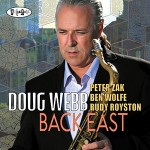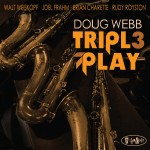
www.allaboutjazz.com
As tempting as it is to simply consign a blowing session label toTriple Play, a three tenor saxophone plus rhythm date led byDoug Webb, there’s ample evidence that something more disciplined and structured is afoot. For one thing, eight of the disc’s eleven tracks are under six minutes—in other words, there’s not a lot of room for indulgence, excess, or one-upmanship of any kind. The material, including striking originals by the leader,Walt Weiskopf, and Joel Frahm, as well as assorted standards such as “Avalon,” “Giant Steps,” and “I Concentrate On You,” is often tendered by the horns like a reed section of a big band, carefully blended and precisely executed. Randy Aldcroft, who doesn’t appear on the record, is credited with the arrangements of three selections.
Organist Brian Charette serves as the session’s ballast, holding things in place with smart, pulsating work on the bass pedals, beautifully shaded and nuanced comping, as well as tweaking soloists with the occasional brash chord. Rudy Royston‘s drums and cymbals constitute the session’s wild card. He offers a busy, sometimes manic commentary, moving in and out of the pocket at will, punching holes in the music with his bass and snare drums, playing stretches of comparatively straight time, as well as tapping out jumbles of strokes.
Webb, Weiskopf, and Frahm are middle-aged veterans of the struggles and triumphs of jazz performance, far too accomplished and certain of their abilities to participate in some sort of spurious tenor battle; thankfully, the record’s end result is a wealth of inspired, highly focused improvisations. The three tenors—each in his own manner—play with a ruthless efficiency, making complete, rousing statements, usually in just a handful of choruses, on selections mostly taken at middling to up tempos.
Webb possesses an exemplary ability to navigate various tempos and find fresh perspectives on material that would induce a litany of clichés in a lesser player. Undaunted by the dizzying pace of “Avalon,” his ideas cohere without a trace of athleticism or strain. A three-chorus turn on Lou Donaldson‘s soul-jazz tune “Alligator Boogaloo” includes relaxed, neatly sculpted phrases as well as the requisite blues and R & B effusions. Throughout “I Concentrate On You,” amidst Charette’s and Royston’s firm support, he swings in a way that evinces a momentum of its own. During the first chorus of his composition “Jones,” Webb makes an art of stopping short, that is cutting off ideas before an easily anticipated conclusion, and then offering something else, without any hint of disengagement or loss of continuity.
It’s easy to become preoccupied with Weiskopf’s tone, a dense, vibrating, all-encompassing, blues-fused concoction, at the expense of taking notice of the ways in which he organizes ideas in the service of sustaining momentum. On his composition “Three’s A Crowd” and Webb’s “Triple Play,” he displays a flair for brief, dramatic entrances—such as slamming home one note and extending it, or making a handful of notes sound like a buzz saw, immediately following with an impassioned, metallic cry—and then rapidly getting down to the business of building a cogent, emotionally compelling improvisation. The second chorus on “The Way Things Are,” another one of his compositions, includes some of Weiskopf’s most stunning work on the record. His lines are taut, tightly connected, and for the most part etched into the hum and rumble of Charette’s bass line. When he pauses, or briefly spins out a flurry of notes that fly against the beat before snapping back to attention, the effect is like an edifice being ripped apart and immediately—miraculously—put back into place.
Each of Frahm’s solos is something of an adventure, as he manipulates his tone, juggles contrasting rhythms, intentionally rushes or drags time, changes temperament from cool to hot, and flashes a number of ideas in relatively short periods. His “Jones” improvisation gradually comes into focus. Frahm lays back for much of the first chorus, playing a little behind the beat and leaving some room between selected phrases. The last eight bars signal a change as his tone assumes a ragged edge. The second chorus begins with the insistent pecking of a number of staccato notes, which he rapidly wrestles into a nifty phrase. Eventually his sound thickens and he integrates squeaks, burr tones, and screams. During “Your Place Or Mine” Frahm evokes jazz of the swing era for about a half chorus in terms of vocabulary and rhythmic nuisances before metamorphosing to the present day. Throughout “Triple Play” he creates tension by playing slightly ahead of the beat, and sprinkles at least three song quotes into the solo’s second chorus.
Not unlike Swing Shift, Webb’s memorable 2012 release on Posi-Tone, Triple Play contains the present centered vibe of the last set of a club date, when the musicians are open to all possibilities, expressing themselves without inhibitions and, for an hour or so, the sounds are strong enough to keep the outside world at bay.
Track Listing: Jones; Three’s A Crowd; Giant Steps; The Way Things Are; Avalon; Jazz Car; Your Place Or Mine; I Concentrate On You; Pail Blues; Alligator Boogaloo; Triple Play.
Personnel: Doug Webb: tenor sax; Walt Weiskopf: tenor sax; Joel Frahm: tenor sax; Brian Charette: organ; Rudy Royston: drums.
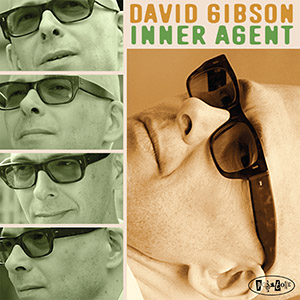 Trombonist David Gibson has created a fine modern mainstream jazz album with his fourth Posi-Tone release. Performing alongside him are Freddie Hendrix on trumpet, Theo Hill on piano, Alexander Claffy on bass, Kush Abadey on drums. Saxophonists Doug Webb and Caleb Curtis guest on a couple of tracks as well. The title track “Inner Agent” opens the album in an up-tempo fashion with bright sounding piano and swinging cymbal play supporting punchy and brash horn riffs. There is an excellent section for the piano, bass and drums unit that swings very hard. “Axe Grinder” sets a funky groove with the horns harmonizing and then breaking free for solo sections, including some stratospheric trumpet. Gibson takes a rapid and smoothly executed trombone solo over rippling piano and subtle bass and drums. There is a fast and exciting sendoff to “The Sythe” with ripe saxophone soloing over muscular playing from the rhythm section, and Abadey’s drums driving the music hard. Gibson gets another nice featured spot, ramping the tempo down just a hair and developing a confident and well-articulated solo. “The Court” has a bouncy and interesting foundation from the piano, bass and drums, while strutting horns come out together and then diverge in short statements before returning to complete this pithy and concise tune. There is a medium tempo sensibility to “Gravy” with swaggering horns sounding good over strong rhythm and percussively comped piano. Gibson’s trombone glides through the rhythm with aplomb demonstrating an appealing tone to his music. The album is completed with a tasteful and restrained version of The Beatles “Here Comes the Sun.” The horns are very subtle and it isn’t until the piano references the melody that the penny drops and you hear what is happening. This performance is emblematic of the entire album, because it is music that is tasteful and thoughtful and should be well received by mainstream jazz fans.
Trombonist David Gibson has created a fine modern mainstream jazz album with his fourth Posi-Tone release. Performing alongside him are Freddie Hendrix on trumpet, Theo Hill on piano, Alexander Claffy on bass, Kush Abadey on drums. Saxophonists Doug Webb and Caleb Curtis guest on a couple of tracks as well. The title track “Inner Agent” opens the album in an up-tempo fashion with bright sounding piano and swinging cymbal play supporting punchy and brash horn riffs. There is an excellent section for the piano, bass and drums unit that swings very hard. “Axe Grinder” sets a funky groove with the horns harmonizing and then breaking free for solo sections, including some stratospheric trumpet. Gibson takes a rapid and smoothly executed trombone solo over rippling piano and subtle bass and drums. There is a fast and exciting sendoff to “The Sythe” with ripe saxophone soloing over muscular playing from the rhythm section, and Abadey’s drums driving the music hard. Gibson gets another nice featured spot, ramping the tempo down just a hair and developing a confident and well-articulated solo. “The Court” has a bouncy and interesting foundation from the piano, bass and drums, while strutting horns come out together and then diverge in short statements before returning to complete this pithy and concise tune. There is a medium tempo sensibility to “Gravy” with swaggering horns sounding good over strong rhythm and percussively comped piano. Gibson’s trombone glides through the rhythm with aplomb demonstrating an appealing tone to his music. The album is completed with a tasteful and restrained version of The Beatles “Here Comes the Sun.” The horns are very subtle and it isn’t until the piano references the melody that the penny drops and you hear what is happening. This performance is emblematic of the entire album, because it is music that is tasteful and thoughtful and should be well received by mainstream jazz fans.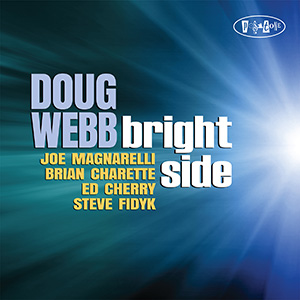 From the very first, sweet strains of tenor saxophone that leap from my CD player, I know it’s Doug Webb. I’ve been listening to his style and enjoying the excitement he creates on stage for three decades. Webb has been featured on over 150 jazz recordings and has added his blues soaked style to tracks used in hundreds of television programs and movies. He’s an on-demand, Southern California, saxophone session man for television and film. This, his seventh album release, is funk-based with Manarelli on trumpet blending well with Webb’s saxophone licks. Webb has penned seven out of the twelve songs on this CD. His composition skills showcase smooth technique and a love of melody. The addition of Charette on organ spices things up and thickens the stew when Webb puts the pots on to boil. This is particularly obvious on cut #3, “The Drive”, where everyone of the musicians seem powered up and propel their improvisational skills at a fast clip. I found Webb’s composition, “Melody for Margie” to be beautiful, promoting a visceral emotion. Another of his compositions I enjoyed immensely is “One For Hank” where Cherry on guitar gers to stretch out, as well as Charette on organ. All in all, this CD swings and Webb is flying above the solid rhythm section, as daring as a man on a trapeze. His music is exciting.
From the very first, sweet strains of tenor saxophone that leap from my CD player, I know it’s Doug Webb. I’ve been listening to his style and enjoying the excitement he creates on stage for three decades. Webb has been featured on over 150 jazz recordings and has added his blues soaked style to tracks used in hundreds of television programs and movies. He’s an on-demand, Southern California, saxophone session man for television and film. This, his seventh album release, is funk-based with Manarelli on trumpet blending well with Webb’s saxophone licks. Webb has penned seven out of the twelve songs on this CD. His composition skills showcase smooth technique and a love of melody. The addition of Charette on organ spices things up and thickens the stew when Webb puts the pots on to boil. This is particularly obvious on cut #3, “The Drive”, where everyone of the musicians seem powered up and propel their improvisational skills at a fast clip. I found Webb’s composition, “Melody for Margie” to be beautiful, promoting a visceral emotion. Another of his compositions I enjoyed immensely is “One For Hank” where Cherry on guitar gers to stretch out, as well as Charette on organ. All in all, this CD swings and Webb is flying above the solid rhythm section, as daring as a man on a trapeze. His music is exciting.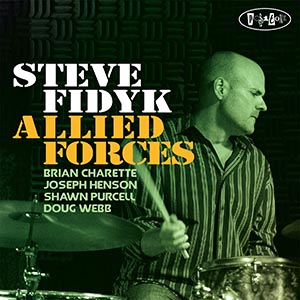 Straight ahead swinging jazz powered by a crew of leaders in their own rights, drummer Fidyk makes no statements here other than he can keep things on track from the back of the stage and that good are meant to be shared by all. Not the kind of feel good jazz you’d associate with water front bars on summer nights but you have to call it that for lack of a better name, this is smoking stuff that works throughout and is the kind of friendly hard core jazz that brings new listeners into the tent despite themselves. On the money throughout and totally hot.
Straight ahead swinging jazz powered by a crew of leaders in their own rights, drummer Fidyk makes no statements here other than he can keep things on track from the back of the stage and that good are meant to be shared by all. Not the kind of feel good jazz you’d associate with water front bars on summer nights but you have to call it that for lack of a better name, this is smoking stuff that works throughout and is the kind of friendly hard core jazz that brings new listeners into the tent despite themselves. On the money throughout and totally hot.